In Silico Prediction of Intestinal Permeability by Hierarchical Support Vector Regression
Abstract
1. Introduction
2. Results
2.1. Data Partition
2.2. SVRE
2.3. HSVR
2.4. Predictive Evaluations
2.5. Mock Test
3. Discussion
4. Materials and Methods
4.1. Data Compilation
4.2. Descriptor Enumeration
4.3. Sample Partition
4.4. Hierarchical Support Vector Regression
4.5. Predictive Assessment
5. Conclusions
Supplementary Materials
Author Contributions
Funding
Acknowledgments
Conflicts of Interest
Abbreviations
| QSAR | Quantitative structure–activity relationship |
| HSVR | Hierarchical support vector regression |
| ADME/Tox | Absorption, distribution, metabolism and excretion, and toxicity |
| BDDCS | Biopharmaceutics drug disposition classification system |
| SLC | Solute carrier |
| ABC | ATP-binding cassette |
| Caco-2 | Colorectal adenocarcinoma |
| MDCK | Madin–Darby canine kidney |
| PAMPA | Parallel artificial membrane permeability assay |
| SPIP | Single-pass intestinal perfusion |
References
- Chi, C.-T.; Lee, M.-H.; Weng, C.-F.; Leong, M.K. In Silico Prediction of PAMPA Effective Permeability Using a Two-QSAR Approach. Int. J. Mol. Sci. 2019, 20, 3170. [Google Scholar] [CrossRef]
- Van de Waterbeemd, H.; Smith, D.A.; Beaumont, K.; Walker, D.K. Property-based design: Optimization of drug absorption and pharmacokinetics. J. Med. Chem. 2001, 44, 1313–1333. [Google Scholar] [CrossRef]
- Soleimani, V.; Sahebkar, A.; Hosseinzadeh, H. Turmeric (Curcuma longa) and its major constituent (curcumin) as nontoxic and safe substances: Review. Phytother. Res. 2018, 32, 985–995. [Google Scholar] [CrossRef]
- Khaerunnisa, S.; Kurniawan, H.; Awaluddin, R.; Suhartati, S.; Soetjipto, S. Potential inhibitor of COVID-19 main protease (Mpro) from several medicinal plant compounds by molecular docking study. Preprints 2020. [Google Scholar] [CrossRef]
- Cheng, D.; Li, W.; Wang, L.; Lin, T.; Poiani, G.; Wassef, A.; Hudlikar, R.; Ondar, P.; Brunetti, L.; Kong, A.-N. Pharmacokinetics, pharmacodynamics, and pkpd modeling of curcumin in regulating antioxidant and epigenetic gene expression in healthy human volunteers. Mol. Pharm. 2019, 16, 1881–1889. [Google Scholar] [CrossRef]
- Zwerling, A. Costs of tuberculosis screening among inpatients with HIV. Lancet Glob. Health 2019, 7, e163–e164. [Google Scholar] [CrossRef]
- Otu, A.; Hashmi, M.; Mukhtar, A.M.; Kwizera, A.; Tiberi, S.; Macrae, B.; Zumla, A.; Dünser, M.W.; Mer, M. The critically ill patient with tuberculosis in intensive care: Clinical presentations, management and infection control. J. Crit. Care 2018, 45, 184–196. [Google Scholar] [CrossRef]
- Schneckener, S.; Grimbs, S.; Hey, J.; Menz, S.; Osmers, M.; Schaper, S.; Hillisch, A.; Göller, A.H. Prediction of oral Bioavailability in Rats: Transferring insights from in vitro correlations to (deep) machine learning models using in silico model outputs and chemical structure parameters. J. Chem. Inf. Model. 2019, 59, 4893–4905. [Google Scholar] [CrossRef]
- Balimane, P.V.; Chong, S.; Morrison, R.A. Current methodologies used for evaluation of intestinal permeability and absorption. J. Pharm. Toxicol. Methods 2000, 44, 301–312. [Google Scholar] [CrossRef]
- Wu, C.-Y.; Benet, L.Z. Predicting drug disposition via application of BCS: Transport/absorption/elimination interplay and development of a biopharmaceutics drug disposition classification system. Pharm. Res. 2005, 22, 11–23. [Google Scholar] [CrossRef]
- Dahlgren, D.; Lennernäs, H. Intestinal permeability and drug absorption: Predictive experimental, computational and in vivo approaches. Pharmaceutics 2019, 11, 411. [Google Scholar] [CrossRef]
- Sugano, K.; Kansy, M.; Artursson, P.; Avdeef, A.; Bendels, S.; Di, L.; Ecker, G.F.; Faller, B.; Fischer, H.; Gerebtzoff, G.; et al. Coexistence of passive and carrier-mediated processes in drug transport. Nat. Rev. Drug Discov. 2010, 9, 597–614. [Google Scholar] [CrossRef]
- Bergström, C.A.S.; Haeberlein, M.; Norinder, U. Computational Absorption Prediction. In Drug Bioavailability: Estimation of Solubility, Permeability, Absorption and Bioavailability; van de Waterbeemd, H., Testa, B., Eds.; Wiley-VCH Verlag GmbH & Co. KGaA: Weinheim, Germany, 2009; Volume 40, pp. 409–432. [Google Scholar]
- Meier, Y.; Eloranta, J.J.; Darimont, J.; Ismair, M.G.; Hiller, C.; Fried, M.; Kullak-Ublick, G.A.; Vavricka, S.R. Regional DISTRIBUTION of solute carrier mRNA expression along the human intestinal tract. Drug Metab. Dispos. 2007, 35, 590–594. [Google Scholar] [CrossRef]
- Seithel, A.; Karlsson, J.; Hilgendorf, C.; Björquist, A.; Ungell, A.-L. Variability in mRNA expression of ABC- and SLC-transporters in human intestinal cells: Comparison between human segments and Caco-2 cells. Eur. J. Pharm. Sci. 2006, 28, 291–299. [Google Scholar] [CrossRef]
- Englund, G.; Rorsman, F.; Rönnblom, A.; Karlbom, U.; Lazorova, L.; Gråsjö, J.; Kindmark, A.; Artursson, P. Regional levels of drug transporters along the human intestinal tract: Co-expression of ABC and SLC transporters and comparison with Caco-2 cells. Eur. J. Pharm. Sci. 2006, 29, 269–277. [Google Scholar] [CrossRef]
- Zakeri-Milani, P.; Valizadeh, H.; Tajerzadeh, H.; Azarmi, Y.; Islambolchilar, Z.; Barzegar, S.; Barzegar-Jalali, M. Predicting human intestinal permeability using single-pass intestinal perfusion in rat. J. Pharm. Pharm. Sci. 2007, 10, 368–379. [Google Scholar]
- Zhu, W.; Jeong, E.J. Intestinal Perfusion Methods for Oral Drug Absorptions. In Oral Bioavailability: Basic Principles, Advanced Concepts, and Applications; Hu, M., Li, X., Eds.; John Wiley & Sons, Inc.: Hoboken, NJ, USA, 2011; pp. 461–473. [Google Scholar]
- Komiya, I.; Park, J.; Kamani, A.; Ho, N.; Higuchi, W. Quantitative mechanistic studies in simultaneous fluid flow and intestinal absorption using steroids as model solutes. Int. J. Pharm. 1980, 4, 249–262. [Google Scholar] [CrossRef]
- Peters, S.A.; Jones, C.R.; Ungell, A.-L.; Hatley, O.J.D. Predicting drug extraction in the human gut wall: Assessing contributions from drug metabolizing enzymes and transporter proteins using preclinical models. Clin. Pharmacokinet. 2016, 55, 673–696. [Google Scholar] [CrossRef]
- Chen, X.-Q.; Ziemba, T.; Huang, C.; Chang, M.; Xu, C.; Qiao, J.X.; Wang, T.C.; Finlay, H.J.; Salvati, M.E.; Adam, L.P.; et al. Oral delivery of highly lipophilic, poorly water-soluble drugs: Self-emulsifying drug delivery systems to improve oral absorption and enable high-dose toxicology studies of a cholesteryl ester transfer protein inhibitor in preclinical species. J. Pharm. Sci. 2018, 107, 1352–1360. [Google Scholar] [CrossRef]
- Cherkasov, A.; Muratov, E.N.; Fourches, D.; Varnek, A.; Baskin, I.I.; Cronin, M.; Dearden, J.; Gramatica, P.; Martin, Y.C.; Todeschini, R.; et al. QSAR modeling: Where have you been? Where are you going to? J. Med. Chem. 2014, 57, 4977–5010. [Google Scholar] [CrossRef]
- Paranjpe, P.V.; Grass, G.M.; Sinko, P.J. In silico tools for drug absorption prediction. Am. J. Drug Deliv. 2003, 1, 133–148. [Google Scholar] [CrossRef]
- Varma, M.V.; Ambler, C.M.; Ullah, M.; Rotter, C.J.; Hao, S.; Litchfield, J.; Fenner, K.S.; El-Kattan, A.F. Targeting intestinal transporters for optimizing oral drug absorption. Curr. Drug Metab. 2010, 11, 730–742. [Google Scholar] [CrossRef]
- David, W.F.; Jeyaganesh, R.; Patrick, D.B.; David, M. Bioavailability through PepT1: The role of computer modelling in intelligent drug design. Curr. Comput. Aided Drug Des. 2010, 6, 68–78. [Google Scholar]
- Chen, C.; Lee, M.-H.; Weng, C.-F.; Leong, M.K. Theoretical prediction of the complex P-glycoprotein substrate efflux based on the novel hierarchical support vector regression scheme. Molecules 2018, 23, 1820. [Google Scholar] [CrossRef]
- Leong, M.K.; Chen, Y.-M.; Chen, T.-H. Prediction of human cytochrome p450 2b6-substrate interactions using hierarchical support vector regression approach. J. Comput. Chem. 2009, 30, 1899–1909. [Google Scholar] [CrossRef]
- Leong, M.K.; Lin, S.-W.; Chen, H.-B.; Tsai, F.-Y. Predicting mutagenicity of aromatic amines by various machine learning approaches. Toxicol. Sci. 2010, 116, 498–513. [Google Scholar] [CrossRef]
- Ding, Y.-L.; Lyu, Y.-C.; Leong, M.K. In silico prediction of the mutagenicity of nitroaromatic compounds using a novel two-QSAR approach. Toxicol. Vitro 2017, 40, 102–114. [Google Scholar] [CrossRef]
- Gnanadesikan, R.; Kettenring, J.R. Robust estimates, residuals, and outlier detection with multiresponse data. Biometrics 1972, 28, 81–124. [Google Scholar] [CrossRef]
- Scott, D.W. Averaged shifted histogram. Wiley Interdiscip. Rev. Comput. Stat. 2010, 2, 160–164. [Google Scholar] [CrossRef]
- Gramatica, P.; Cassani, S.; Chirico, N. QSARINS-chem: Insubria datasets and new QSAR/QSPR models for environmental pollutants in QSARINS. J. Comput. Chem. 2014, 35, 1036–1044. [Google Scholar] [CrossRef]
- Gajewicz, A. How to judge whether QSAR/read-across predictions can be trusted: A novel approach for establishing a model’s applicability domain. Environ. Sci. Nano 2018, 5, 408–421. [Google Scholar] [CrossRef]
- Rücker, C.; Rücker, G.; Meringer, M. y-Randomization and its variants in QSPR/QSAR. J. Chem. Inf. Model. 2007, 47, 2345–2357. [Google Scholar] [CrossRef] [PubMed]
- Caudill, M. Using neural networks: Hybrid expert networks. AI Expert 1990, 5, 49–54. [Google Scholar]
- Golbraikh, A.; Shen, M.; Xiao, Z.; Xiao, Y.-D.; Lee, K.-H.; Tropsha, A. Rational selection of training and test sets for the development of validated QSAR models. J. Comput. Aided Mol. Des. 2003, 17, 241–253. [Google Scholar] [CrossRef] [PubMed]
- Ojha, P.K.; Mitra, I.; Das, R.N.; Roy, K. Further exploring rm2 metrics for validation of QSPR models. Chemom. Intell. Lab. Syst. 2011, 107, 194–205. [Google Scholar] [CrossRef]
- Roy, K.; Mitra, I.; Kar, S.; Ojha, P.K.; Das, R.N.; Kabir, H. Comparative studies on some metrics for external validation of QSPR models. J. Chem. Inf. Model. 2012, 52, 396–408. [Google Scholar] [CrossRef] [PubMed]
- Chirico, N.; Gramatica, P. Real external predictivity of QSAR models. Part 2. New intercomparable thresholds for different validation criteria and the need for scatter plot inspection. J. Chem. Inf. Model. 2012, 52, 2044–2058. [Google Scholar] [CrossRef]
- Lennernäs, H. Regional intestinal drug permeation: Biopharmaceutics and drug development. Eur. J. Pharm. Sci. 2014, 57, 333–341. [Google Scholar] [CrossRef]
- Zhao, Y.H.; Le, J.; Abraham, M.H.; Hersey, A.; Eddershaw, P.J.; Luscombe, C.N.; Boutina, D.; Beck, G.; Sherborne, B.; Cooper, I.; et al. Evaluation of human intestinal absorption data and subsequent derivation of a quantitative structure-activity relationship (QSAR) with the Abraham descriptors. J. Pharm. Sci. 2001, 90, 749–784. [Google Scholar] [CrossRef]
- Verma, R.; Hansch, C.; Selassie, C. Comparative QSAR studies on PAMPA/modified PAMPA for high throughput profiling of drug absorption potential with respect to Caco-2 cells and human intestinal absorption. J. Comput. Aided Mol. Des. 2007, 21, 3–22. [Google Scholar] [CrossRef]
- Polley, M.J.; Burden, F.R.; Winkler, D.A. Predictive human intestinal absorption QSAR models using bayesian regularized neural networks. Aust. J. Chem. 2005, 58, 859–863. [Google Scholar] [CrossRef]
- Zhao, Y.H.; Abraham, M.H.; Le, J.; Hersey, A.; Luscombe, C.N.; Beck, G.; Sherborne, B.; Cooper, I. Rate-limited steps of human oral absorption and QSAR studies. Pharm. Res. 2002, 19, 1446–1457. [Google Scholar] [CrossRef] [PubMed]
- Gunturi, S.B.; Ramamurthi, N. In silico adme modeling 3: Computational models to predict human intestinal absorption using sphere exclusion and kNN QSAR methods. QSAR Comb. Sci. 2007, 26, 653–668. [Google Scholar] [CrossRef]
- Moda, T.L.; Andricopulo, A.D. Consensus hologram QSAR modeling for the prediction of human intestinal absorption. Bioorg. Med. Chem. Lett. 2012, 22, 2889–2893. [Google Scholar] [CrossRef]
- Basant, N.; Gupta, S.; Singh, K.P. Predicting human intestinal absorption of diverse chemicals using ensemble learning based QSAR modeling approaches. Comput. Biol. Chem. 2016, 61, 178–196. [Google Scholar] [CrossRef] [PubMed]
- Silva, F.T.; Trossini, G.H.G. The survey of the use of qsar methods to determine intestinal absorption and oral bioavailability during drug design. Med. Chem. 2014, 10, 441–448. [Google Scholar] [CrossRef] [PubMed]
- Deconinck, E.; Coomans, D.; Vander Heyden, Y. Exploration of linear modelling techniques and their combination with multivariate adaptive regression splines to predict gastro-intestinal absorption of drugs. J. Pharm. Biomed. Anal. 2007, 43, 119–130. [Google Scholar] [CrossRef]
- Reynolds, D.P.; Lanevskij, K.; Japertas, P.; Didziapetris, R.; Petrauskas, A. Ionization-specific analysis of human intestinal absorption. J. Pharm. Sci. 2009, 98, 4039–4054. [Google Scholar] [CrossRef]
- Suenderhauf, C.; Hammann, F.; Maunz, A.; Helma, C.; Huwyler, J. Combinatorial QSAR modeling of human intestinal absorption. Mol. Pharm. 2011, 8, 213–224. [Google Scholar] [CrossRef]
- Ghafourian, T.; Freitas, A.A.; Newby, D. The impact of training set data distributions for modelling of passive intestinal absorption. Int. J. Pharm. 2012, 436, 711–720. [Google Scholar] [CrossRef][Green Version]
- Toropov, A.A.; Toropova, A.P.; Benfenati, E.; Dorne, J.L. SAR for gastro-intestinal absorption and blood-brain barrier permeation of pesticides. Chem. Biol. Interact. 2018, 290, 1–5. [Google Scholar] [CrossRef] [PubMed]
- Wang, N.-N.; Huang, C.; Dong, J.; Yao, Z.-J.; Zhu, M.-F.; Deng, Z.-K.; Lv, B.; Lu, A.-P.; Chen, A.F.; Cao, D.-S. Predicting human intestinal absorption with modified random forest approach: A comprehensive evaluation of molecular representation, unbalanced data, and applicability domain issues. RSC Adv. 2017, 7, 19007–19018. [Google Scholar] [CrossRef]
- Kumar, R.; Sharma, A.; Siddiqui, M.H.; Tiwari, R.K. Prediction of human intestinal absorption of compounds using artificial intelligence techniques. Curr. Drug Discov. Technol. 2017, 14, 244–254. [Google Scholar] [CrossRef] [PubMed]
- Shultz, M.D. Two decades under the influence of the rule of five and the changing properties of approved oral drugs. J. Med. Chem. 2019, 62, 1701–1714. [Google Scholar] [CrossRef]
- Broccatelli, F.; Salphati, L.; Plise, E.; Cheong, J.; Gobbi, A.; Lee, M.L.; Aliagas, I. Predicting passive permeability of drug-like molecules from chemical structure: Where are we? Mol. Pharm. 2016, 13, 4199–4208. [Google Scholar] [CrossRef]
- Kishimoto, H.; Miyazaki, K.; Shirasaka, Y.; Inoue, K. Effect of mucus layer on the transcellular absorption of lipophilic drugs in rat small intestine. FASEB J. 2018, 32, 761.1. [Google Scholar] [CrossRef]
- Ertl, P.; Rohde, B.; Selzer, P. Fast calculation of molecular polar surface area as a sum of fragment-based contributions and its application to the prediction of drug transport properties. J. Med. Chem. 2000, 43, 3714–3717. [Google Scholar] [CrossRef]
- Meanwell, N.A. Improving drug candidates by design: A focus on physicochemical properties as a means of improving compound disposition and safety. Chem. Res. Toxicol. 2011, 24, 1420–1456. [Google Scholar] [CrossRef]
- Desai, P.V.; Raub, T.J.; Blanco, M.-J. How hydrogen bonds impact P-glycoprotein transport and permeability. Bioorg. Med. Chem. Lett. 2012, 22, 6540–6548. [Google Scholar] [CrossRef]
- Ferreira, R.J.; dos Santos, D.J.V.A.; Ferreira, M.-J.U.; Guedes, R.C. Toward a better pharmacophore description of p-glycoprotein modulators, based on macrocyclic diterpenes from euphorbia species. J. Chem. Inf. Model. 2011, 51, 1315–1324. [Google Scholar] [CrossRef]
- Leong, M.K.; Chen, H.-B.; Shih, Y.-H. Prediction of promiscuous P-glycoprotein inhibition using a novel machine learning scheme. PLoS ONE 2012, 7, e33829. [Google Scholar] [CrossRef] [PubMed]
- Didziapetris, R.; Japertas, P.; Avdeef, A.; Petrauskas, A. Classification analysis of P-glycoprotein substrate specificity. J. Drug Target. 2003, 11, 391–406. [Google Scholar] [CrossRef] [PubMed]
- Tmej, C.; Chiba, P.; Huber, M.; Richter, E.; Hitzler, M.; Schaper, K.-J.; Ecker, G. A Combined hansch/free-wilson approach as predictive tool in qsar studies on propafenone-type modulators of multidrug resistance. Arch. Pharm. 1998, 331, 233–240. [Google Scholar] [CrossRef]
- Hiessböck, R.; Wolf, C.; Richter, E.; Hitzler, M.; Chiba, P.; Kratzel, M.; Ecker, G. Synthesis and in vitro multidrug resistance modulating activity of a series of dihydrobenzopyrans and tetrahydroquinolines. J. Med. Chem. 1999, 42, 1921–1926. [Google Scholar] [CrossRef]
- Agatonovic-Kustrin, S.; Beresford, R.; Yusof, A.P.M. Theoretically-derived molecular descriptors important in human intestinal absorption. J. Pharm. Biomed. Anal. 2001, 25, 227–237. [Google Scholar] [CrossRef]
- Hou, T.; Wang, J.; Zhang, W.; Wang, W.; Xu, X. Recent advances in computational prediction of drug absorption and permeability in drug discovery. Curr. Med. Chem. 2006, 13, 2653–2667. [Google Scholar] [CrossRef]
- Bain, L.J.; McLachlan, J.B.; LeBlanc, G.A. Structure-activity relationships for xenobiotic transport substrates and inhibitory ligands of P-glycoprotein. Environ. Health Perspect. 1997, 105, 812–818. [Google Scholar] [CrossRef]
- Mollazadeh, S.; Moosavi, F.; Hadizadeh, F.; Seifi, M.; Behravan, J.; Iman, M. Synthesis and DFT study on hantzsch reaction to produce asymmetrical compounds of 1,4-dihydropyridine derivatives for P-glycoprotein inhibition as anticancer agent. Recent Pat. Anticancer Drug Discov. 2018, 13, 255–264. [Google Scholar] [CrossRef]
- Newstead, S.; Drew, D.; Cameron, A.D.; Postis, V.L.G.; Xia, X.; Fowler, P.W.; Ingram, J.C.; Carpenter, E.P.; Sansom, M.S.P.; McPherson, M.J.; et al. Crystal structure of a prokaryotic homologue of the mammalian oligopeptide–proton symporters, PepT1 and PepT2. EMBO J. 2011, 30, 417–426. [Google Scholar] [CrossRef]
- Golin, J.; Ambudkar, S.V.; Gottesman, M.M.; Habib, A.D.; Sczepanski, J.; Ziccardi, W.; May, L. Studies with novel Pdr5p substrates demonstrate a strong size dependence for xenobiotic efflux. J. Biol. Chem. 2003, 278, 5963–5969. [Google Scholar] [CrossRef]
- Varma, M.V.S.; Sateesh, K.; Panchagnula, R. Functional role of P-glycoprotein in limiting intestinal absorption of drugs: Contribution of passive permeability to P-glycoprotein mediated efflux transport. Mol. Pharm. 2005, 2, 12–21. [Google Scholar] [CrossRef] [PubMed]
- Pauletti, G.M.; Okumu, F.W.; Borchardt, R.T. Effect of size and charge on the passive diffusion of peptides across Caco-2 cell monolayers via the paracellular pathway. Pharm. Res. 1997, 14, 164–168. [Google Scholar] [CrossRef]
- Gerebtzoff, G.; Seelig, A. In silico prediction of blood-brain barrier permeation using the calculated molecular cross-sectional area as main parameter. J. Chem. Inf. Model. 2006, 46, 2638–2650. [Google Scholar] [CrossRef] [PubMed]
- Leeson, P.D.; St-Gallay, S.A.; Wenlock, M.C. Impact of ion class and time on oral drug molecular properties. Med. Chem. Comm. 2011, 2, 91–105. [Google Scholar] [CrossRef]
- Chu, X.-Y.; Sánchez-Castaño, G.P.; Higaki, K.; Oh, D.-M.; Hsu, C.-P.; Amidon, G.L. Correlation between epithelial cell permeability of cephalexin and expression of intestinal oligopeptide transporter. J. Pharmacol. Exp. Ther. 2001, 299, 575–582. [Google Scholar]
- Dahan, A.; Amidon, G. Grapefruit juice and its constituents augment colchicine intestinal absorption: Potential hazardous interaction and the role of P-glycoprotein. Pharm. Res. 2009, 26, 883–892. [Google Scholar] [CrossRef]
- Deng, D.-D.; Liu, C.-Y.; Liao, Z.-X.; Liang, J.-Y.; Lu, J.-Z. Prediction of passive transport of 10 natural products by liposome-based fluorescence technique. Chin. J. Anal. Chem. 2007, 35, 1696–1700. [Google Scholar]
- Fagerholm, U.; Johansson, M.; Lennernäs, H. Comparison between permeability coefficients in rat and human jejunum. Pharm. Res. 1996, 13, 1336–1342. [Google Scholar] [CrossRef]
- Fang, L.; Wang, Q.; Bi, K.; Zhao, X. Simultaneous determination of procaspase activating compound 1 and permeability markers in intestinal perfusion samples and application to a rat intestinal absorption study. Chromatographia 2016, 79, 1659–1663. [Google Scholar] [CrossRef]
- Incecayir, T.; Tsume, Y.; Amidon, G.L. Comparison of the permeability of metoprolol and labetalol in rat, mouse, and Caco-2 cells: Use as a reference standard for BCS classification. Mol. Pharm. 2013, 10, 958–966. [Google Scholar] [CrossRef]
- Jain, R.; Agarwal, S.; Mandava, N.K.; Sheng, Y.; Mitra, A.K. Interaction of dipeptide prodrugs of saquinavir with multidrug resistance protein-2 (MRP-2): Evasion of MRP-2 mediated efflux. Int. J. Pharm. 2008, 362, 44–51. [Google Scholar] [CrossRef] [PubMed]
- Kang, M.J.; Kim, H.S.; Jeon, H.S.; Park, J.H.; Lee, B.S.; Ahn, B.K.; Moon, K.Y.; Choi, Y.W. In situ intestinal permeability and in vivo absorption characteristics of olmesartan medoxomil in self-microemulsifying drug delivery system. Drug Dev. Ind. Pharm. 2012, 38, 587–596. [Google Scholar] [CrossRef] [PubMed]
- Kim, J.-S.; Mitchell, S.; Kijek, P.; Tsume, Y.; Hilfinger, J.; Amidon, G.L. The suitability of an in situ perfusion model for permeability determinations: Utility for BCS class I biowaiver requests. Mol. Pharm. 2006, 3, 686–694. [Google Scholar] [CrossRef] [PubMed]
- Krondahl, E.; Orzechowski, A.; Ekström, G.; Lennernäs, H. Rat jejunal permeability and metabolism of μ-selective tetrapeptides in gastrointestinal fluids from humans and rats. Pharm. Res. 1997, 14, 1780–1785. [Google Scholar] [CrossRef] [PubMed]
- Lindahl, A.; Sandström, R.; Ungell, A.L.; Lennernäs, H. Concentration-and region-dependent intestinal permeability of fluvastatin in the Rat. J. Pharm. Pharmacol. 1998, 50, 737–744. [Google Scholar] [CrossRef]
- Lindahl, A.; Persson, B.; Ungell, A.-L.; Lennernäs, H. Surface activity and concentration dependent intestinal permeability in the rat. Pharm. Res. 1999, 16, 97–102. [Google Scholar] [CrossRef]
- Liu, Y.; Hu, M. Absorption and metabolism of flavonoids in the caco-2 cell culture model and a perused rat intestinal model. Drug Metab. Dispos. 2002, 30, 370–377. [Google Scholar] [CrossRef]
- Liu, C.; Liu, D.; Bai, F.; Zhang, J.; Zhang, N. In vitro and in vivo studies of lipid-based nanocarriers for oral N3-o-toluyl-fluorouracil delivery. Drug Deliv. 2010, 17, 352–363. [Google Scholar] [CrossRef]
- Lozoya-Agullo, I.; Zur, M.; Wolk, O.; Beig, A.; González-Álvarez, I.; González-Álvarez, M.; Merino-Sanjuán, M.; Bermejo, M.; Dahan, A. In-situ intestinal rat perfusions for human Fabs prediction and BCS permeability class determination: Investigation of the single-pass vs. the doluisio experimental approaches. Int. J. Pharm. 2015, 480, 1–7. [Google Scholar] [CrossRef]
- Masaoka, Y.; Tanaka, Y.; Kataoka, M.; Sakuma, S.; Yamashita, S. Site of drug absorption after oral administration: Assessment of membrane permeability and luminal concentration of drugs in each segment of gastrointestinal tract. Eur. J. Pharm. Sci. 2006, 29, 240–250. [Google Scholar] [CrossRef]
- Nagare, N.; Damre, A.; Singh, K.; Mallurwar, S.; Iyer, S.; Naik, A.; Chintamaneni, M. Determination of site of absorption of propranolol in rat gut using in situ single-pass intestinal perfusion. Indian J. Pharm. Sci. 2010, 72, 625–629. [Google Scholar]
- Ozawa, M.; Tsume, Y.; Zur, M.; Dahan, A.; Amidon, G.L. Intestinal permeability study of minoxidil: Assessment of minoxidil as a high permeability reference drug for biopharmaceutics classification. Mol. Pharm. 2014, 12, 204–211. [Google Scholar] [CrossRef]
- Patel, J.; Barve, K.H. Intestinal permeability of lamivudine using single pass intestinal perfusion. Indian J. Pharm. Sci. 2012, 74, 478–481. [Google Scholar]
- Shashikanth, P.; Mohan, P.C.; Karunakar, K.; Sagi, S.R. Paclitaxel disposition studies using P-Gp inhibtor & inducer by single pass intestinal perfusion in rats. Asian J. Pharm. Clin. Res. 2013, 1, 199–203. [Google Scholar]
- Steffansen, B.; Lepist, E.-I.; Taub, M.E.; Larsen, B.D.; Frokjaer, S.; Lennernäs, H. Stability, metabolism and transport of d-Asp (OBzl)–Ala—a model prodrug with affinity for the oligopeptide transporter. Eur. J. Pharm. Sci. 1999, 8, 67–73. [Google Scholar] [CrossRef]
- Stewart, B.H.; Chan, O.H.; Lu, R.H.; Reyner, E.L.; Schmid, H.L.; Hamilton, H.W.; Steinbaugh, B.A.; Taylor, M.D. Comparison of intestinal permeabilities determined in multiple in vitro and in situ models: Relationship to absorption in humans. Pharm. Res. 1995, 12, 693–699. [Google Scholar] [CrossRef]
- Miertuš, S.; Scrocco, E.; Tomasi, J. Electrostatic interaction of a solute with a continuum. A direct utilizaion of AB initio molecular potentials for the prevision of solvent effects. Chem. Phys. 1981, 55, 117–129. [Google Scholar] [CrossRef]
- Cammi, R.; Tomasi, J. Remarks on the use of the apparent surface charges (ASC) methods in solvation problems: Iterative versus matrix-inversion procedures and the renormalization of the apparent charges. J. Comput. Chem. 1995, 16, 1449–1458. [Google Scholar] [CrossRef]
- Besler, B.H.; Merz, K.M.J.; Kollman, P.A. Atomic charges derived from semiempirical methods. J. Comput. Chem. 1990, 11, 431–439. [Google Scholar] [CrossRef]
- Muehlbacher, M.; Spitzer, G.; Liedl, K.; Kornhuber, J. Qualitative prediction of blood–brain barrier permeability on a large and refined dataset. J. Comput. Aided Mol. Des. 2011, 25, 1095–1106. [Google Scholar] [CrossRef]
- Topliss, J.G.; Edwards, R.P. Chance factors in studies of quantitative structure-activity relationships. J. Med. Chem. 1979, 22, 1238–1244. [Google Scholar] [CrossRef] [PubMed]
- Tseng, Y.J.; Hopfinger, A.J.; Esposito, E.X. The great descriptor melting pot: Mixing descriptors for the common good of QSAR models. J. Comput. Aided Mol. Des. 2012, 26, 39–43. [Google Scholar] [CrossRef] [PubMed]
- Rogers, D.; Hopfinger, A.J. Application of genetic function approximation to quantitative structure-activity relationships and quantitative structure-property relationships. J. Chem. Inf. Comput. Sci. 1994, 34, 854–866. [Google Scholar] [CrossRef]
- Guyon, I.; Weston, J.; Barnhill, S.; Vapnik, V. Gene selection for cancer classification using support vector machines. Mach. Learn. 2002, 46, 389–422. [Google Scholar] [CrossRef]
- Hubert, M.; Engelen, S. Robust PCA and classification in biosciences. Bioinformatics 2004, 20, 1728–1736. [Google Scholar] [CrossRef]
- Tropsha, A.; Gramatica, P.; Gombar, V.K. The importance of being earnest: Validation is the absolute essential for successful application and interpretation of QSPR models. QSAR Comb. Sci. 2003, 22, 69–77. [Google Scholar] [CrossRef]
- Cortes, C.; Vapnik, V. Support-vector networks. Mach. Learn. 1995, 20, 273–297. [Google Scholar] [CrossRef]
- Vapnik, V.; Golowich, S.; Smola, A. Support Vector Method for Function Approximation, Regression Estimation, and Signal Processing. In Advances in Neural Information Processing Systems 9; Mozer, M.C., Jordan, M.I., Petsche, T., Eds.; MIT Press: Cambridge, MA, USA, 1997; pp. 281–287. [Google Scholar]
- Kecman, V. Learning and Soft Computing: Support Vector Machines, Neural Networks, and Fuzzy Logic Models; MIT Press: Cambridge, MA, USA, 2001; 576p. [Google Scholar]
- Dearden, J.C.; Cronin, M.T.D.; Kaiser, K.L.E. How not to develop a quantitative structure–activity or structure–property relationship (QSAR/QSPR). SAR QSAR Environ. Res. 2009, 20, 241–266. [Google Scholar] [CrossRef]
- Gramatica, P.; Chirico, N.; Papa, E.; Cassani, S.; Kovarich, S. QSARINS: A new software for the development, analysis, and validation of QSAR MLR models. J. Comput. Chem. 2013, 34, 2121–2132. [Google Scholar] [CrossRef]
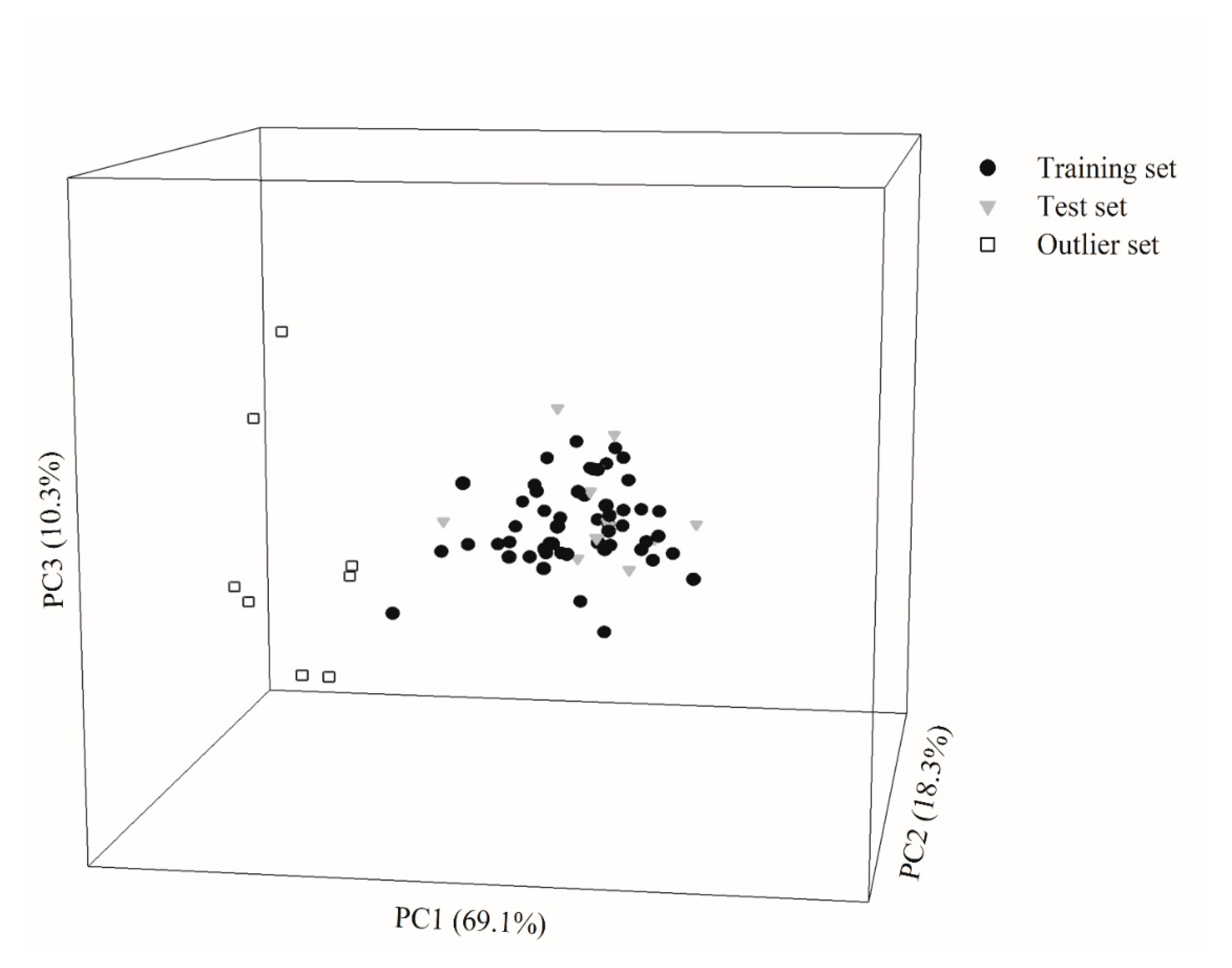
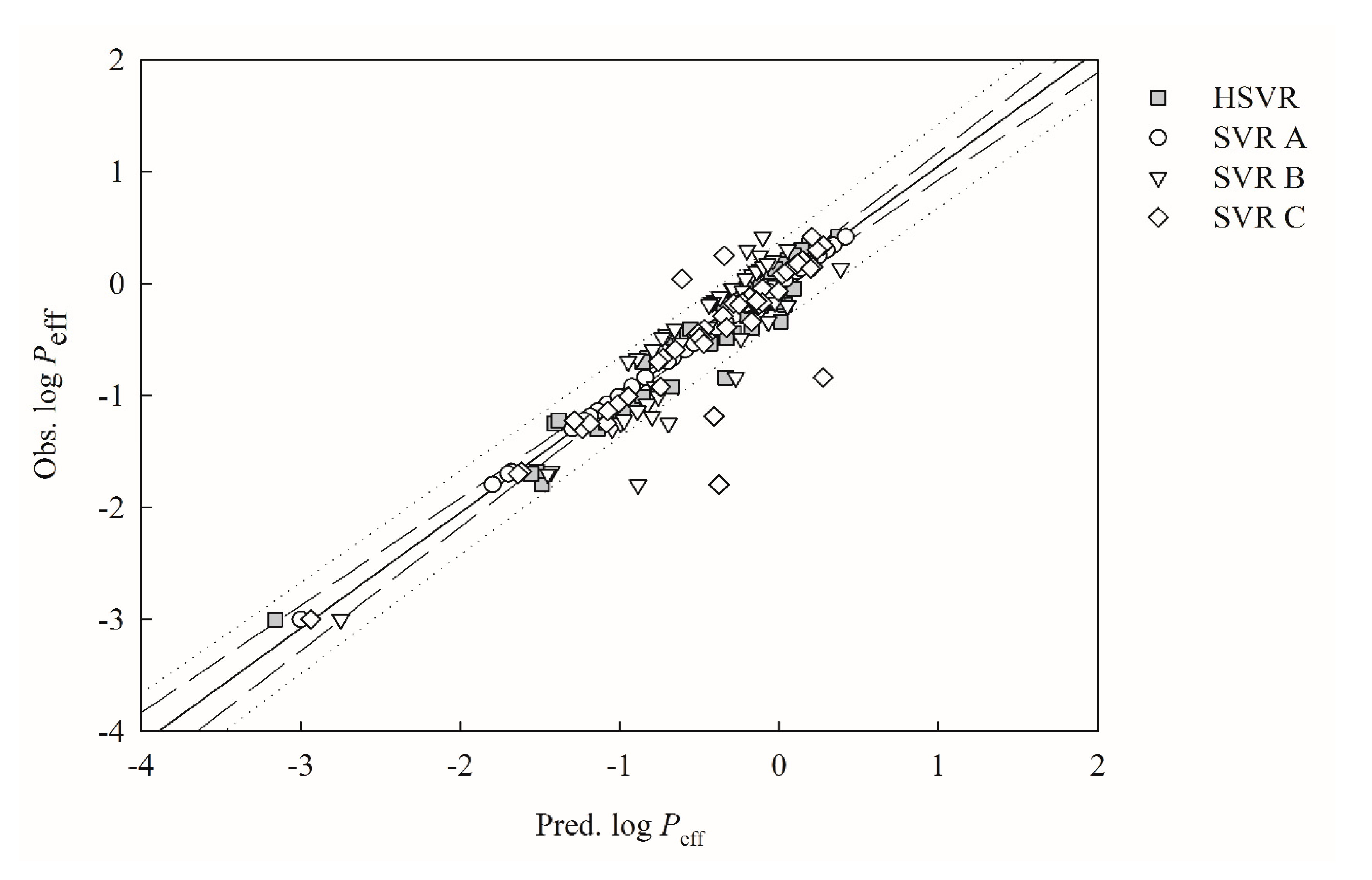
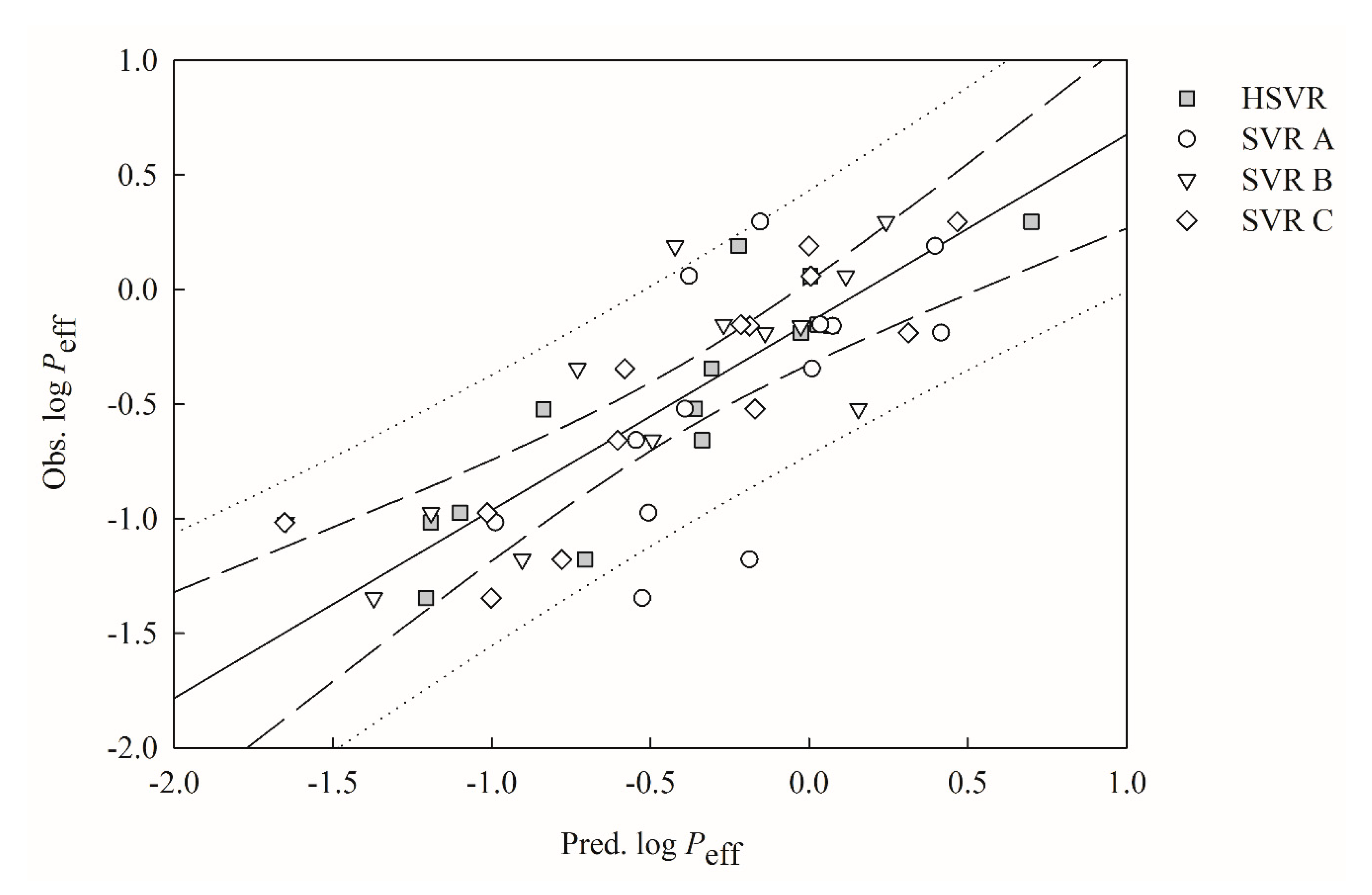


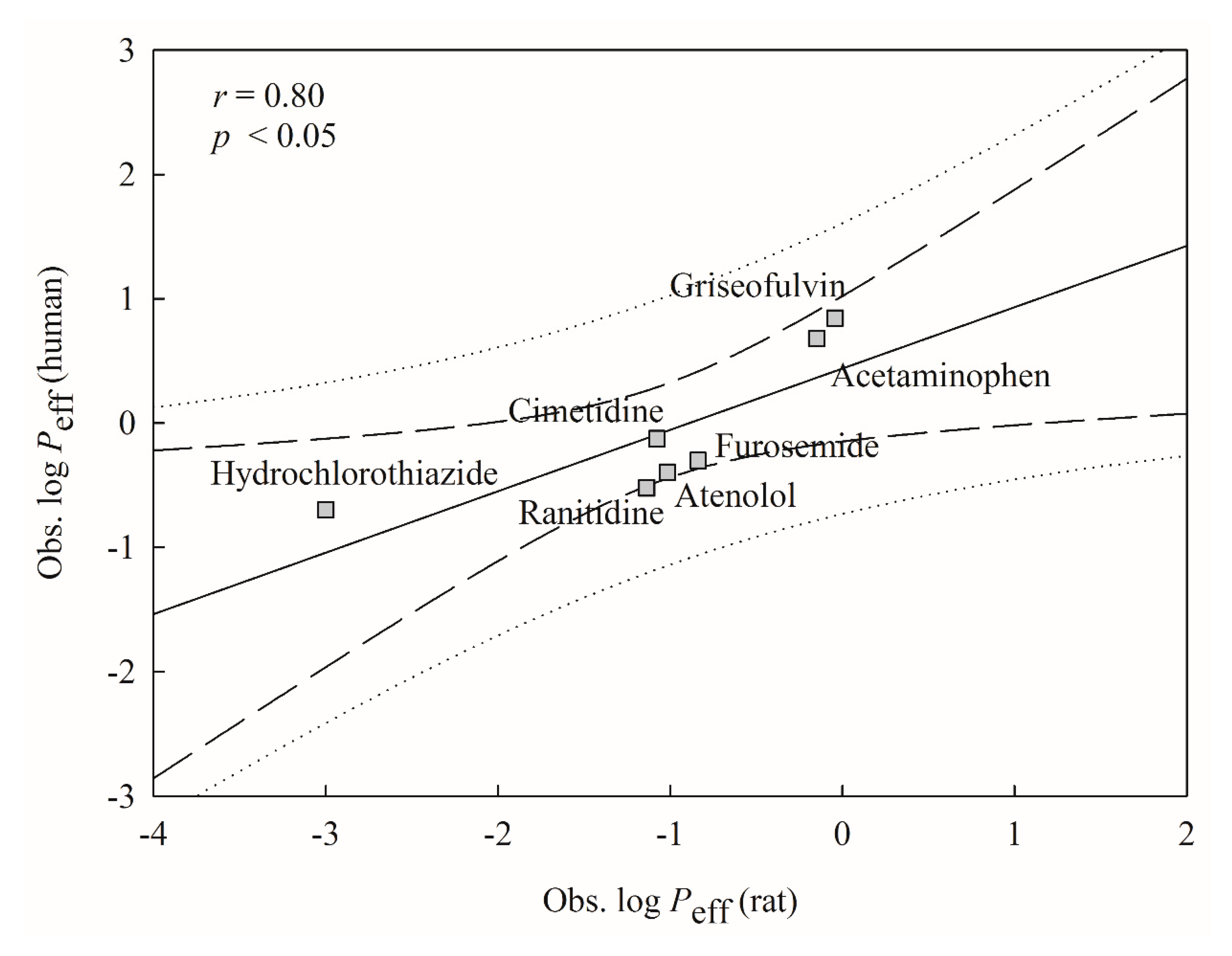


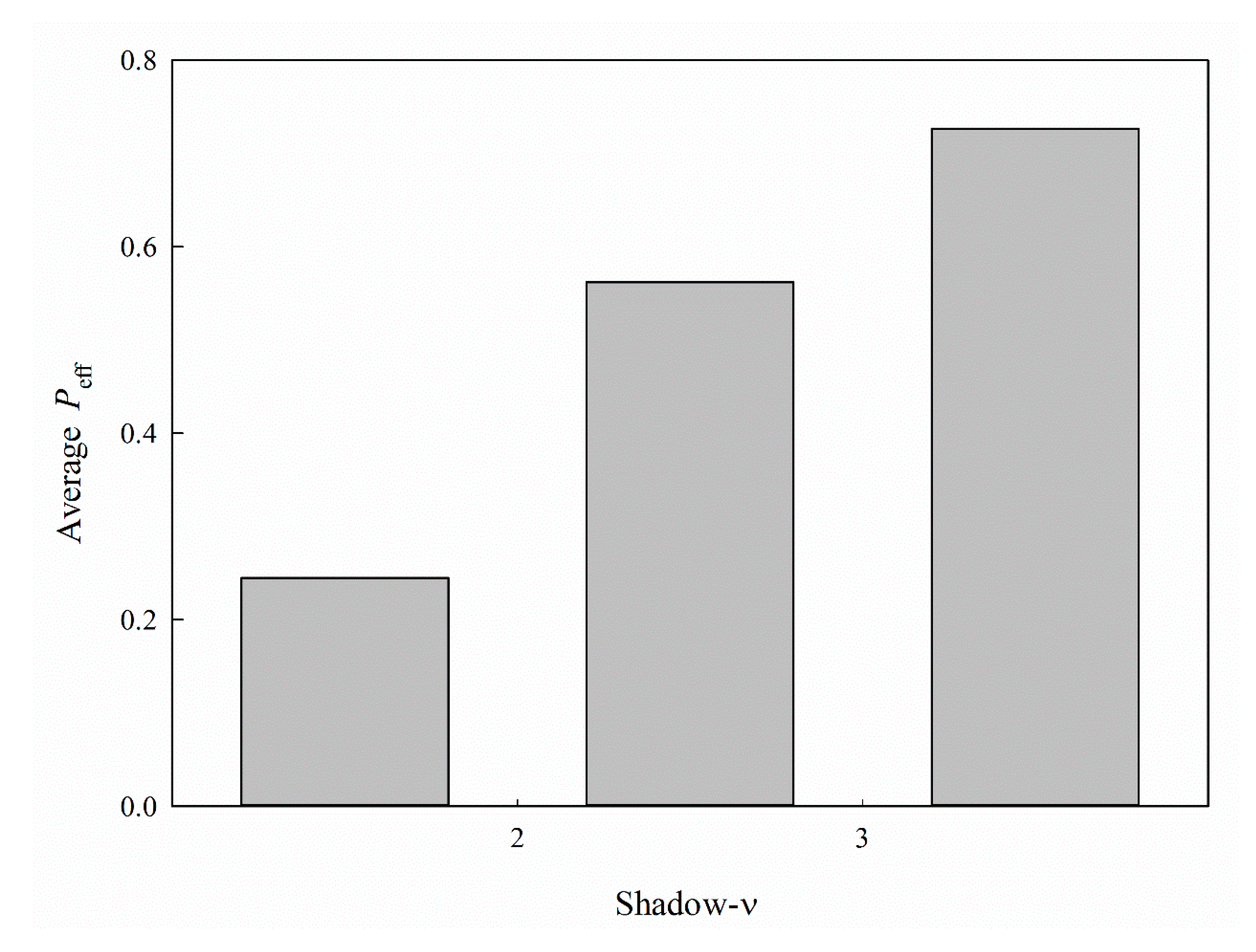
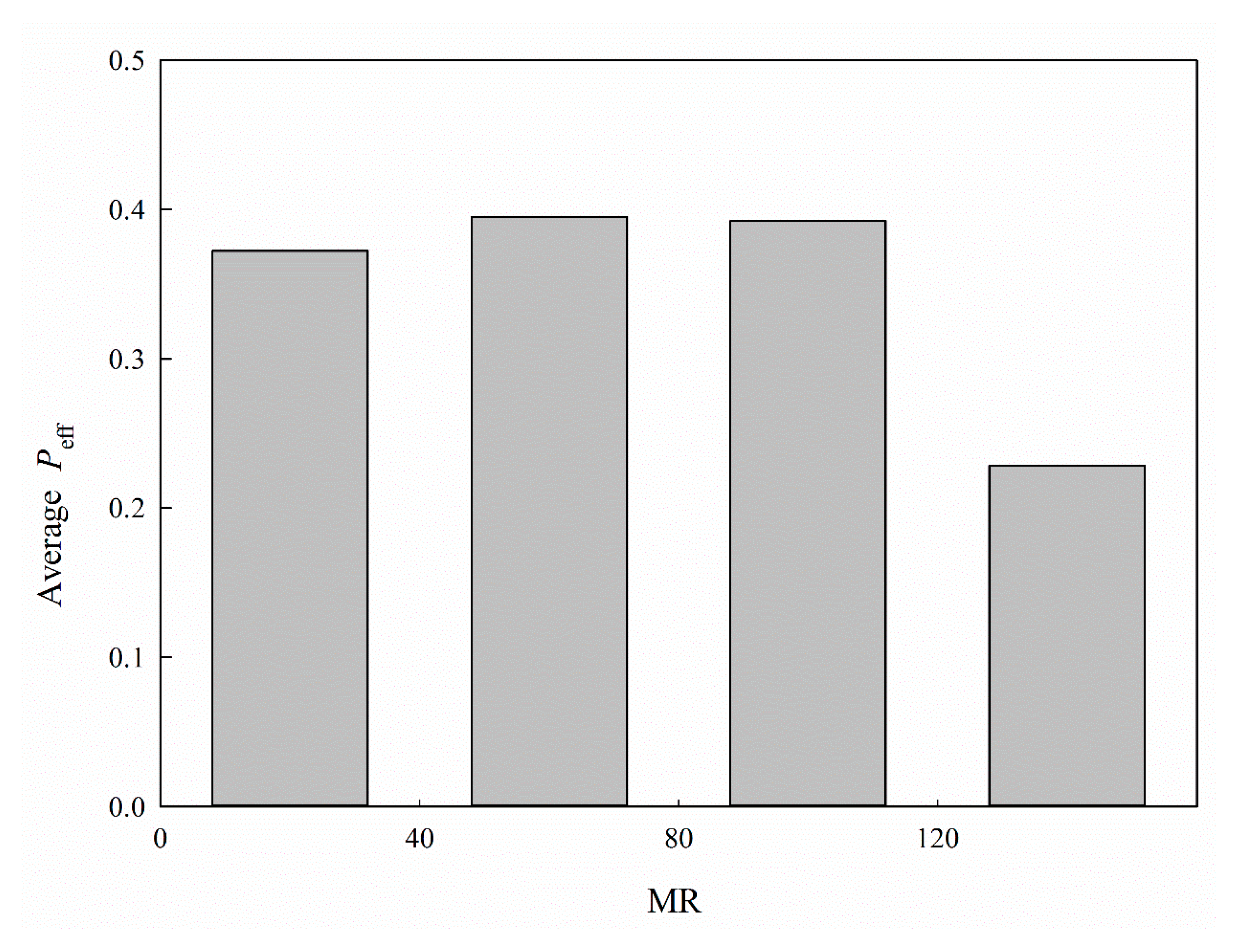
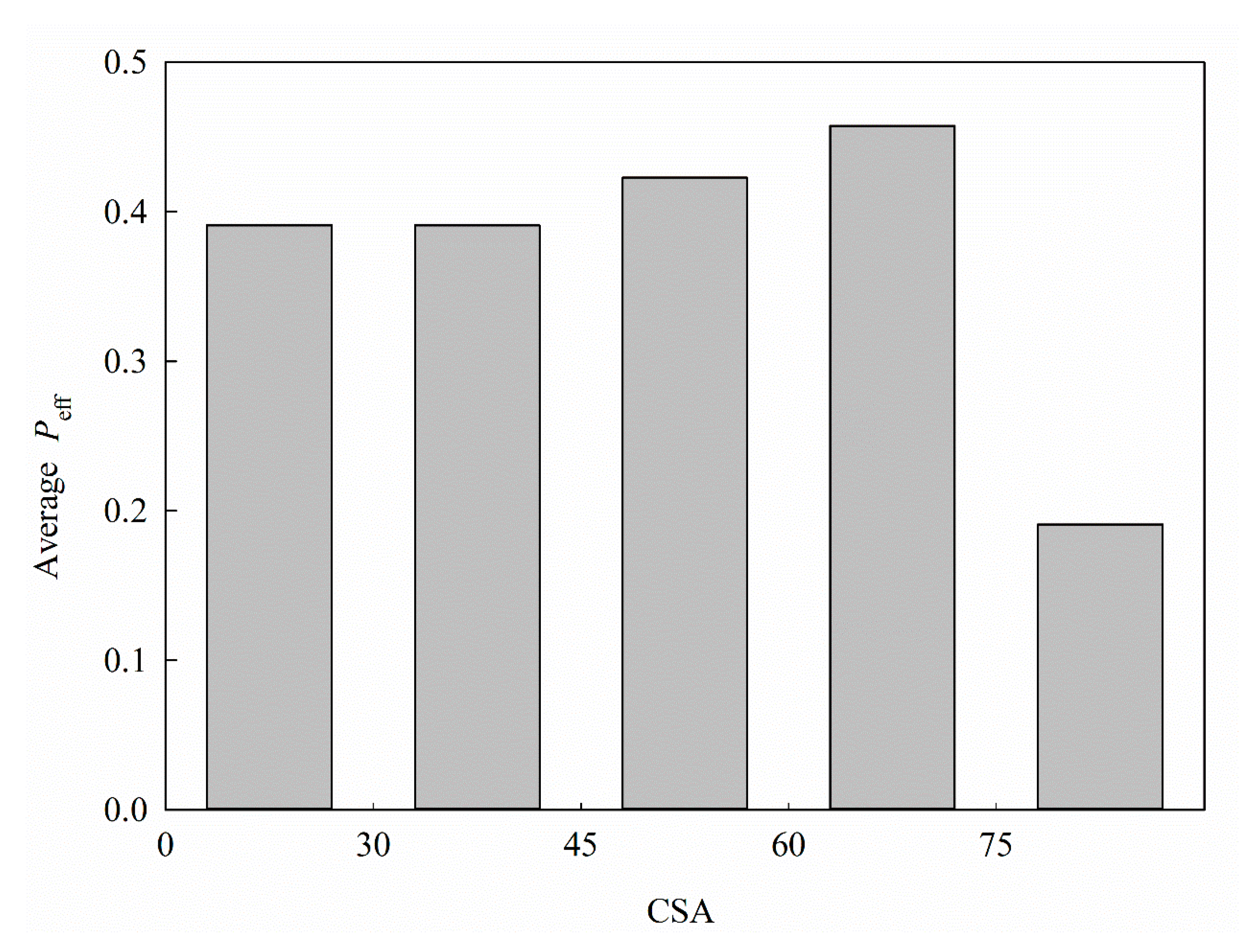
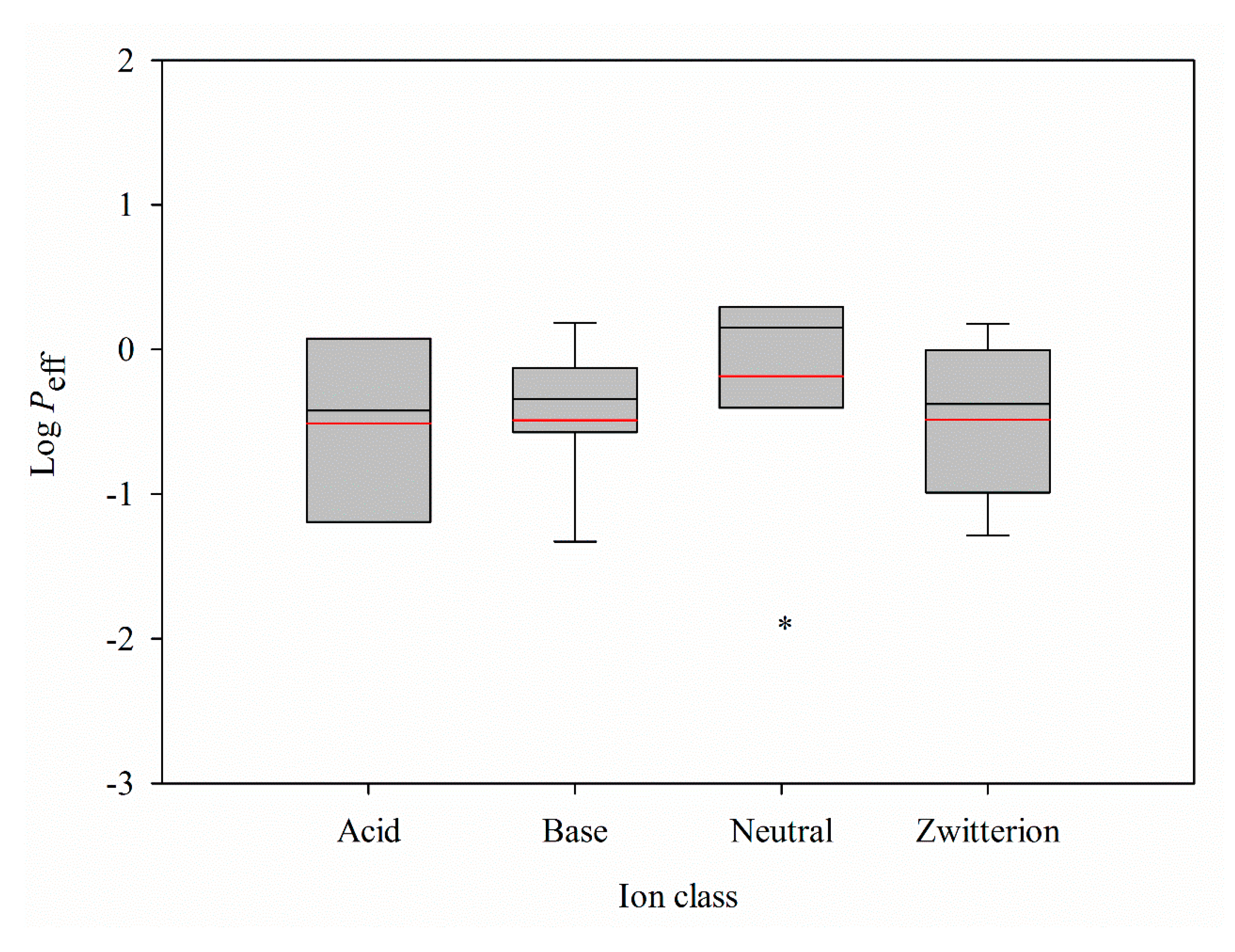
| Descriptor | SVR A | SVR B | SVR C | r | Description |
|---|---|---|---|---|---|
| μ | X † | X | X | −0.16 | Dipole moment of molecule |
| Log D | X | X | 0.23 | Logarithm of the n-octanol–water partition coefficient at PH 6.5 | |
| Log P | X | 0.22 | Logarithm of the n-octanol–water partition coefficient | ||
| HBD | X | X | −0.07 | Hydrogen-bond donor | |
| nN+O | X | −0.29 | Number of nitrogen and oxygen | ||
| Shadow-ν | X | 0.23 | Ratio of largest to smallest dimension | ||
| MR | X | X | −0.12 | Sum of molar refractivity of substituents |
| SVR A | SVR B | SVR C | HSVR | |
|---|---|---|---|---|
| r2 | 0.62 | 0.83 | 0.79 | 0.93 |
| ΔMax | 1.18 | 0.91 | 1.42 | 0.50 |
| MAE | 0.33 | 0.25 | 0.15 | 0.16 |
| s | 0.26 | 0.15 | 0.27 | 0.08 |
| RMSE | 0.42 | 0.29 | 0.31 | 0.17 |
| 0.12 | 0.02 | 0.07 | 0.84 | |
| 0.02 | 0.02 | 0.02 | 0.02 |
| SVR A | SVR B | SVR C | HSVR | |
|---|---|---|---|---|
| q2 | 0.40 | 0.67 | 0.73 | 0.81 |
| 0.15 | 0.55 | 0.66 | 0.75 | |
| 0.15 | 0.55 | 0.66 | 0.75 | |
| 0.50 | 0.73 | 0.79 | 0.85 | |
| CCC | 0.55 | 0.82 | 0.86 | 0.89 |
| ΔMax | 0.99 | 0.68 | 0.64 | 0.47 |
| MAE | 0.39 | 0.26 | 0.24 | 0.22 |
| s | 0.29 | 0.24 | 0.20 | 0.14 |
| RMSE | 0.47 | 0.35 | 0.30 | 0.26 |
| SVR A | SVR B | SVR C | HSVR | |
|---|---|---|---|---|
| q2 | 0.34 | 0.63 | 0.72 | 0.83 |
| −0.10 | 0.04 | 0.47 | 0.78 | |
| −0.11 | 0.04 | 0.47 | 0.78 | |
| 0.58 | 0.64 | 0.80 | 0.92 | |
| CCC | 0.34 | 0.40 | 0.65 | 0.89 |
| ΔMax | 0.97 | 0.64 | 0.52 | 0.31 |
| MAE | 0.33 | 0.36 | 0.26 | 0.17 |
| s | 0.29 | 0.19 | 0.16 | 0.09 |
| RMSE | 0.43 | 0.40 | 0.30 | 0.19 |
| Training Set | Test Set | Outlier Set | |
|---|---|---|---|
| 0.94 | 0.75 | 0.83 | |
| k | 1.04 | 0.99 | 0.87 |
| 0.93 | 0.80 | 0.78 | |
| 0.88 | 0.66 | 0.76 | |
| 0.90 | 0.74 | 0.67 | |
| 0.89 | 0.70 | 0.71 | |
| 0.02 | 0.08 | 0.08 | |
| Equation (16) | X † | X | X |
| Equation (17) | X | N/A | N/A |
| Equation (18) | X | X | X |
| Equation (19) | X | X | X |
| Equation (20) | X | X | X |
| Equation (21) | X | X | X |
| Equation (22) | N/A a | X | X |
© 2020 by the authors. Licensee MDPI, Basel, Switzerland. This article is an open access article distributed under the terms and conditions of the Creative Commons Attribution (CC BY) license (http://creativecommons.org/licenses/by/4.0/).
Share and Cite
Lee, M.-H.; Ta, G.H.; Weng, C.-F.; Leong, M.K. In Silico Prediction of Intestinal Permeability by Hierarchical Support Vector Regression. Int. J. Mol. Sci. 2020, 21, 3582. https://doi.org/10.3390/ijms21103582
Lee M-H, Ta GH, Weng C-F, Leong MK. In Silico Prediction of Intestinal Permeability by Hierarchical Support Vector Regression. International Journal of Molecular Sciences. 2020; 21(10):3582. https://doi.org/10.3390/ijms21103582
Chicago/Turabian StyleLee, Ming-Han, Giang Huong Ta, Ching-Feng Weng, and Max K. Leong. 2020. "In Silico Prediction of Intestinal Permeability by Hierarchical Support Vector Regression" International Journal of Molecular Sciences 21, no. 10: 3582. https://doi.org/10.3390/ijms21103582
APA StyleLee, M.-H., Ta, G. H., Weng, C.-F., & Leong, M. K. (2020). In Silico Prediction of Intestinal Permeability by Hierarchical Support Vector Regression. International Journal of Molecular Sciences, 21(10), 3582. https://doi.org/10.3390/ijms21103582






